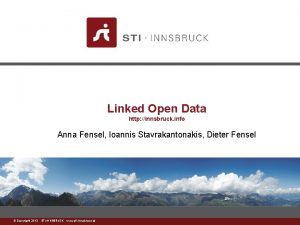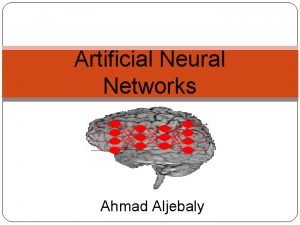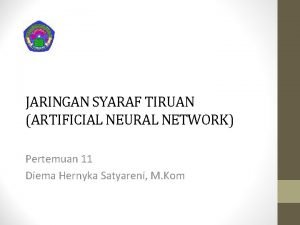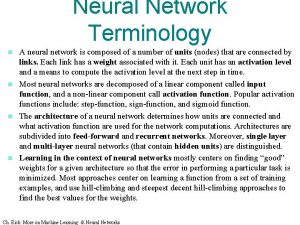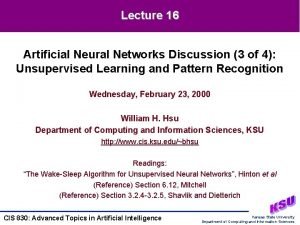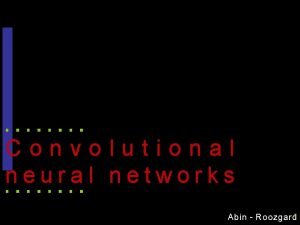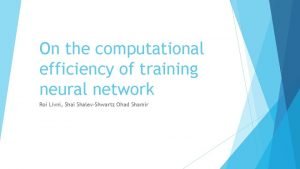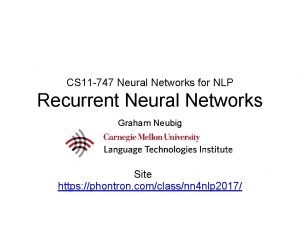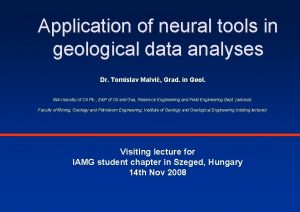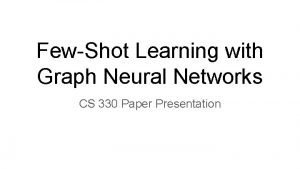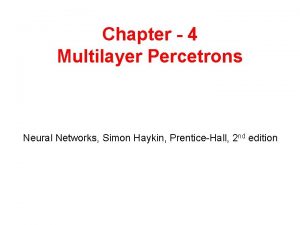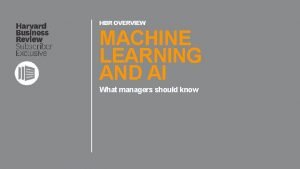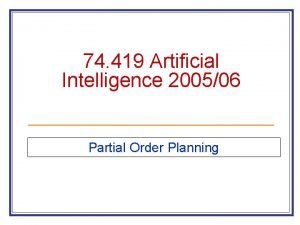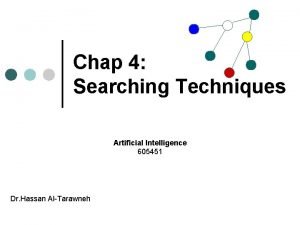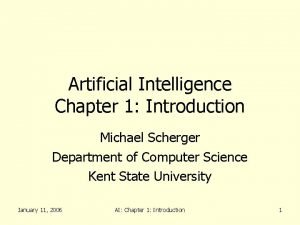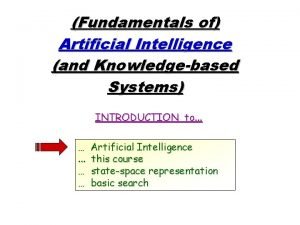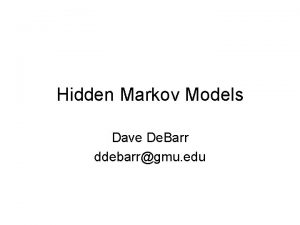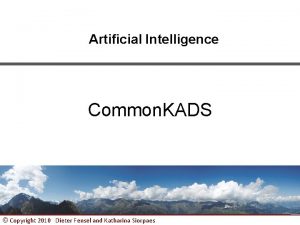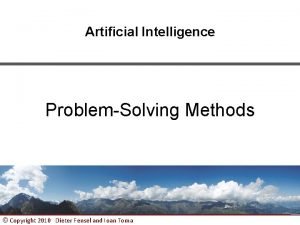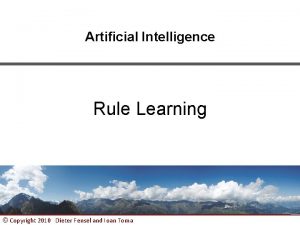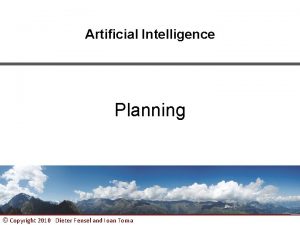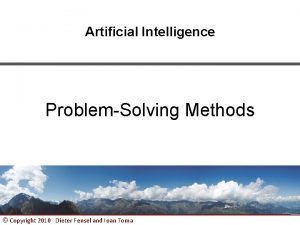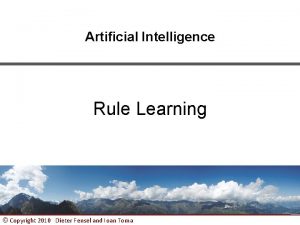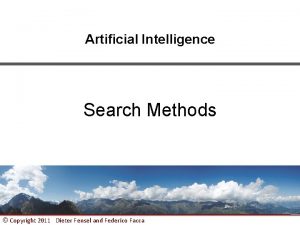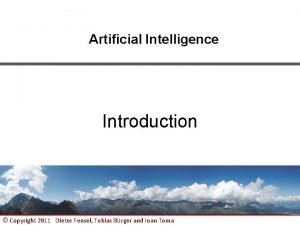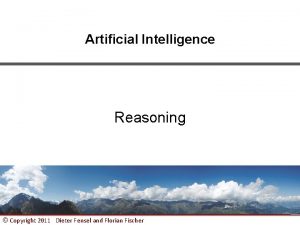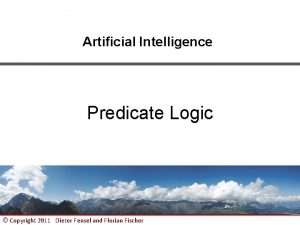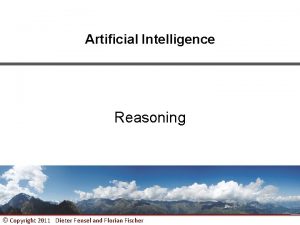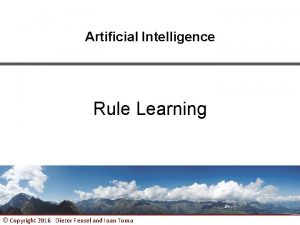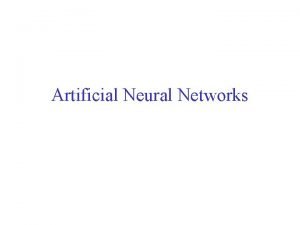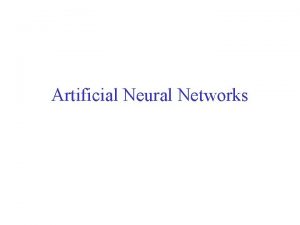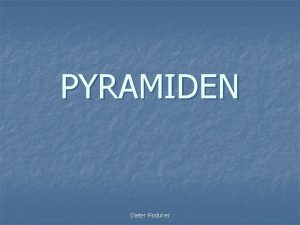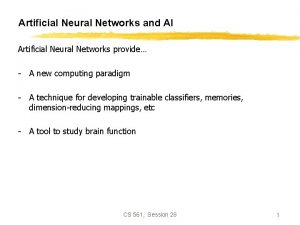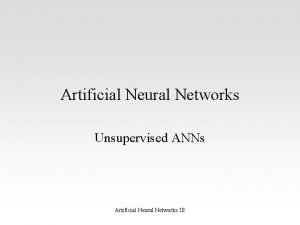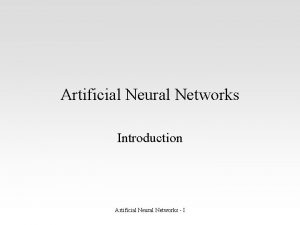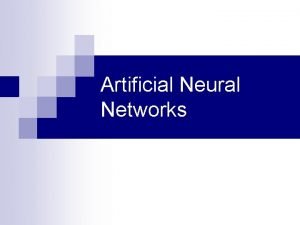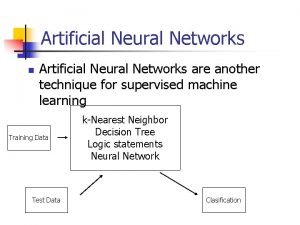Artificial Intelligence Neural Networks Copyright 2010 Dieter Fensel




























































- Slides: 60

Artificial Intelligence Neural Networks © Copyright 2010 Dieter Fensel and Reto Krummenacher 1

Where are we? # Title 1 Introduction 2 Propositional Logic 3 Predicate Logic 4 Reasoning 5 Search Methods 6 Common. KADS 7 Problem-Solving Methods 8 Planning 9 Software Agents 10 Rule Learning 11 Inductive Logic Programming 12 Formal Concept Analysis 13 Neural Networks 14 Semantic Web and Services 2

Agenda • Motivation • Technical Solution – – – (Artificial) Neural Networks Perceptron Artificial Neural Network Structures Learning and Generalization Expressiveness of Multi-Layer Perceptrons • Illustration by Larger Examples • Summary 3

MOTIVATION 4 4

Motivation • A main motivation behind neural networks is the fact that symbolic rules do not reflect reasoning processes performed by humans. • Biological neural systems can capture highly parallel computations based on representations that are distributed over many neurons. • They learn and generalize from training data; no need for programming it all. . . • They are very noise tolerant – better resistance than symbolic systems. 5

Motivation • Neural networks are stong in: – Learning from a set of examples – Optimizing solutions via constraints and cost functions – Classification: grouping elements in classes – Speech recognition, pattern matching – Non-parametric statistical analysis and regressions 6

TECHNICAL SOLUTIONS 7 7

(Artificial) Neural Networks 8 8

What are Neural Networks? • A biological neural network is composed of groups of chemically connected or functionally associated neurons. • A single neuron may be connected to many other neurons and the total number of neurons and connections in a network may be extensive. • Neurons are highly specialized cells that transmit impulses within animals to cause a change in a target cell such as a muscle effector cell or a glandular cell. • Impulses are noisy “spike trains” of electronical potential. • Apart from the electrical signaling, neurotransmitter diffusion (endogenous chemicals) can effectuate the impulses. 9

What are Neural Networks? • Connections, called synapses, are usually formed from axons to dendrites; also other connections are possible. • The axon is the primary conduit through which the neuron transmits impulses to neurons downstream in the signal chain • A human has 1011 neurons of > 20 types, 1014 synapses, 1 ms 10 ms cycle time. • There are 1011 in a galaxy, and 1011 galaxies in the universe. • Not only the impulse carries value but also the frequency of oscillation, hence neural networks have an even higher complexity. 10

What are Neural Networks? • Metaphorically speaking, a thought is a specific self-oscillation of a network of neurons. • The topology of the network determines its resonance. • However, it is the resonance in the brain's interaction with the environment and with itself that creates, reinforces or decouples interaction patterns. • The brain is not a static device, but a device that is created through usage… 11

What are Neural Networks? • What we refer to as Neural Networks, in this course, are mostly Artificial Neural Networks (ANN). • ANN are approximations of biological neural networks and are built of physical devices, or simulated on computers. • ANN are parallel computational entities that consist of multiple simple processing units that are connected in specific ways in order to perform the desired tasks. • Remember: ANN are computationally primitive approximations of the real biological brains. 12

Perceptron 13 13

Artificial Neurons - Mc. Culloch-Pitts „Unit“ • Output is a „squashed“ linear function of the inputs: • A clear oversimplification of real neurons, but its purpose is to develop understanding of what networks of simple units can do. 14

Activation Functions (a) is a step function or threshold function, signum function (b) is a sigmoid function 1/(1+e-x) • Changing the bias weight W 0, i moves the threshold location 15

Perceptron • Mc. Culloch-Pitts neurons can be connected together in any desired way to build an artificial neural network. • A construct of one input layer of neurons that feed forward to one output layer of neurons is called Perceptron. Input units Output units Ij Wj, i Oi Perceptron Network Input units Ouput unit Ij Wj O Single Perceptron 16

Expressiveness of Perceptrons • A perceptron with g = step function can model Boolean functions and linear classification: – As we will see, a perceptron can represent AND, OR, NOT, but not XOR • A perceptron represents a linear separator for the input space ∑j. Wjaj > 0 a 1 a 1 a 2 a 2 a 1 a 2 17

Expressiveness of Perceptrons (2) • Threshold perceptrons can represent only linearly separable functions (i. e. functions for which such a separation hyperplane exists) a 1 0 0 a 2 • Such perceptrons have limited expressivity. • There exists an algorithm that can fit a threshold perceptron to any linearly separable training set. 18

Example: Logical Functions a 0 a 1 W 0 = 1. 5 a 1 W 0 = 0. 5 W 0 = -0. 5 W 1 = 1 a 2 a 0 W 2 = 1 a 2 AND W 2 = 1 a 1 OR W 1 = -1 NOT • Mc. Culloch and Pitts: Boolean function can be implemented with a artificial neuron (not XOR). 19

Example: Finding Weights for AND Operation • There are two input weights W 1 and W 2 and a treshold W 0. For each training pattern the perceptron needs to satisfay the following equation: out = g(W 1*a 1 + W 2*a 2 – W 0) = sign(W 1*a 1 + W 2*a 2 – W 0) • For a binary AND there are four training data items available that lead to four inequalities: – W 1*0 + W 2*0 – W 0 < 0 ⇒ W 0 > 0 – W 1*0 + W 2*1 – W 0 < 0 ⇒ W 2 < W 0 – W 1*1 + W 2*0 – W 0 < 0 ⇒ W 1 < W 0 – W 1*1 + W 2*1 – W 0 ≥ 0 ⇒ W 1 + W 2 ≥ W 0 • There is an obvious infinite number of solutions that realize a logical AND; e. g. W 1 = 1, W 2 = 1 and W 0 = 1. 5. 20

Limitations of Simple Perceptrons • XOR: – W 1*0 + W 2*0 – W 0 < 0 – W 1*0 + W 2*1 – W 0 ≥ 0 – W 1*1 + W 2*0 – W 0 ≥ 0 – W 1*1 + W 2*1 – W 0 < 0 ⇒ ⇒ W 0 > 0 W 2 ≥ W 0 W 1 + W 2 < W 0 • The 2 nd and 3 rd inequalities are not compatible with inequality 4, and there is no solution to the XOR problem. • XOR requires two separation hyperplanes! • There is thus a need for more complex networks that combine simple perceptrons to address more sophisticated classification tasks. 21

Artificial Neural Network Structures 22 22

Neural Network Structures • Mathematically artificial neural networks are represented by weighted directed graphs. • In more practical terms, a neural network has activations flowing between processing units via one-way connections. • There are three common artificial neural network architectures known: – Single-Layer Feed-Forward (Perceptron) – Multi-Layer Feed-Forward – Recurrent Neural Network 23

Single-Layer Feed-Forward • A Single-Layer Feed-Forward Structure is a simple perceptron, and has thus – one input layer – one output layer – NO feed-back connections • Feed-forward networks implement functions, have no internal state (of course also valid for multi-layer perceptrons). 24

Single-Layer Feed-Forward: Example • Output units all operate separately – no shared weights • Adjusting weights moves the location, orientation, and steepness of cliff (i. e. , the separation hyperplane). a 2 a 1 Input units Wj, i Output units 25

Multi-Layer Feed-Forward • Multi-Layer Feed-Forward Structures have: – one input layer – one output layer – one or many hidden layers of processing units • The hidden layers are between the input and the output layer, and thus hidden from the outside world: no input from the world, not output to the world. 26

Multi-Layer Feed-Forward (2) • Multi-Layer Perceptrons (MLP) have fully connected layers. • The numbers of hidden units is typically chosen by hand; the more layers, the more complex the network (see Step 2 of Building Neural Networks) • Hidden layers enlarge the space of hypotheses that the network can represent. • Learning done by back-propagation algorithm → errors are back-propagated from the output layer to the hidden layers. 27

Simple MLP Example • XOR Problem: Recall that XOR cannot be modeled with a Single-Layer Feed-Forward perceptron. 1 3 2 28

Expressiveness of MLPs • 1 hidden layer can represent all continuous functions • 2 hidden layers can represent all functions • Combining two opposite-facing threshold functions makes a ridge. • Combining two perpendicular ridges makes a bump. • Add bumps of various sizes and locations to fit any surface. • The more hidden units, the more bumps. 29

Number of Hidden Layers • Rule of Thumb 1 Even if the function to learn is slightly non-linear, the generalization may be better with a simple linear model than with a complicated non-linear model; if there is too little data or too much noise to estimate the non-linearities accurately. • Rule of Thumb 2 If there is only one input, there seems to be no advantage to using more than one hidden layer; things get much more complicated when there are two or more inputs. 30

Example: Number of Hidden Layers 1 st layer draws linear boundaries 2 nd layer combines the boundaries. 3 rd layer can generate arbitrarily boundaries. 31

Recurrent Network • Recurrent networks have at least one feedback connection: – They have directed cycles with delays: they have internal states (like flip flops), can oscillate, etc. – The response to an input depends on the initial state which may depend on previous inputs. – This creates an internal state of the network which allows it to exhibit dynamic temporal behaviour; offers means to model short-time memory 32

Building Neural Networks • Building a neural network for particular problems requires multiple steps: 1. Determine the input and outputs of the problem; 2. Start from the simplest imaginable network, e. g. a single feed-forward perceptron; 3. Find the connection weights to produce the required output from the given training data input; 4. Ensure that the training data passes successfully, and test the network with other training/testing data; 5. Go back to Step 3 if performance is not good enough; 6. Repeat from Step 2 if Step 5 still lacks performance; or 7. Repeat from Step 1 if the network in Step 6 does still not perform well enough. 33

Learning and Generalization 34 34

Learning and Generalization • Neural networks have two important aspects to fulfill: – They must learn decision surfaces from training data, so that training data (and test data) are classified correctly; – They must be able to generalize based on the learning process, in order to classify data sets it has never seen before. • Note that there is an important trade-off between the learning behavior and the generalization of a neural network (called overfitting) • The better a network learns to successfully classify a training sequence (that might contain errors) the less flexible it is with respect to arbitrary data. 35

Learning vs. Generalization • Noise in the actual data is never a good thing, since it limits the accuracy of generalization that can be achieved no matter how extensive the training set is. • Non-perfect learning is better in this case! Regression Classification „Perfect“ learning achieves the dotted separation, while the desired one is in fact given by the solid line. • However, injecting artificial noise (so-called jitter) into the inputs during training is one of several ways to improve generalization 36

Estimation of Generalization Error • There are many methods for estimating generalization errors. • Single-sample statistics – Statistical theory provides estimators for the generalization error in non-linear models with a "large" training set. • Split-sample or hold-out validation. – The most commonly used method: reserve some data as a "test set”, which must not be used during training. – The test set must represent the cases that the ANN should generalize to. – A re-run with the random test set provides an unbiased estimate of the generalization error. – The disadvantage of split-sample validation is that it reduces the amount of data available for both training and validation. 37

Estimation of Generalization Error • Cross-validation (e. g. , leave one out). – In k-fold cross-validation the data is divided into k subsets, and the network is trained k times, each time leaving one subset out for computing the error. – The “crossing” makes this method an improvement over splitsampling; it allows all data to be used for training. – The disadvantage of cross-validation is that the network must be re-trained many times (k times in k-fold crossing). • Bootstrapping. – Bootstrapping works on random sub-samples (random shares) that are chosen from the full data set. – Any data item may be selected any number of times for validation. – The sub-samples are repeatedly analyzed. • No matter which method is applied, the estimate of the generalization error of the best network will be optimistic. 38

Algorithm for ANN Learning • Learning is based on training data, and aims at appropriate weights for the perceptrons in a network. • Direct computation is in the general case not feasible. • An initial random assignment of weights simplifies the learning process that becomes an iterative adjustment process. • In the case of single perceptrons, learning becomes the process of moving hyperplanes around; parametrized over time t: Wi(t+1) = Wi(t) + ΔWi(t) 39

Perceptron Learning • The squared error for an example with input x and desired output y is: • Perform optimization search by gradient descent: • Simple weight update rule: • Positive error ⇒ increase network output • increase weights on positive inputs, • decrease on negative inputs 40

Perceptron Learning (2) • The weight updates need to be applied repeatedly for each weight Wj in the network, and for each training suite in the training set. • One such cycle through all weighty is called an epoch of training. • Eventually, mostly after many epochs, the weight changes converge towards zero and the training process terminates. • The perceptron learning process always finds a set of weights for a perceptron that solves a problem correctly with a finite number of epochs, if such a set of weights exists. • If a problem can be solved with a separation hyperplane, then the set of weights is found in finite iterations and solves the problem correctly. 41

Perceptron Learning (3) • Perceptron learning rule converges to a consistent function for any linearly separable data set • Perceptron learns majority function easily, Decision-Tree is hopeless • Decision-Tree learns restaurant function easily, perceptron cannot represent it. 42

Example Functions • Majority Function: the output is false when n/2 or more inputs are false, and true otherwise. • Restaurant Function: decide whether to wait for a table or not: – How many guests (patron) are in the restaurant? – What is the estimated waiting time? – Any alternative restaurant nearby? – Are we hungry? – Do we have a reservation? – Is it Friday or Saturday? – Is there a comfortable bar area to wait in? – Is it raining outside? 43

Perceptron Learning (3) • Perceptron learning rule converges to a consistent function for any linearly separable data set • Perceptron learns majority function easily, Decision-Tree is hopeless • Decision-Tree learns restaurant function easily, perceptron cannot represent it. 44

Back-Propagation Learning • The errors (and therefore the learning) propagate backwards from the output layer to the hidden layers. • Learning at the output layer is the same as for single-layer perceptron: • Hidden layer neurons get a "blame" assigned for the error (backpropagation of error), giving greater responsibility to neurons connected by stronger weight. • Back-propagation of error updates the weights of the hidden layer; the principle thus stays the same. 45

Back-Propagation Learning (2) • Training curve for 100 restaurant examples converges to a perfect fit to the training data • MLPs are quite good for complex pattern recognition tasks, but resulting hypotheses cannot be understood easily • Typical problems: slow convergence, local minima 46

ILLUSTRATION BY AN EXAMPLE 47 47

Perceptron Learning Example • The applied algorithm is as follows – Initialize the weights and threshold to small random numbers. – Present a vector x to the neuron inputs and calculate the output. – Update the weights according to the error. • Applied learning function: + 1+ • Example with two inputs x 1, x 2 o 0 x 1 o 1 48

Perceptron Learning Example • Data: (0, 0) 0, (1, 0) 0, (0, 1) 1, (1, 1) 1 • Initialization: W 1(0) = 0. 9286, W 2(0) = 0. 62, W 0(0) = 0. 2236, α = 0. 1 • Training – epoch 1: out 1 = sign(0. 92*0 + 0. 62*0 – 0. 22) = sign(-0. 22) = 0 out 2 = sign(0. 92*1 + 0. 62*0 – 0. 22) = sign(0. 7) = 1 X W 1(1) = 0. 92 + 0. 1 * (0 – 1) * 1 = 0. 82 W 2(1) = 0. 62 + 0. 1 * (0 – 1) * 0 = 0. 62 W 0(1) = 0. 22 + 0. 1 * (0 – 1) * (-1)= 0. 32 out 3 = sign(0. 82*0 + 0. 62*1 – 0. 32) = sign(0. 5) = 1 out 4 = sign(0. 82*1 + 0. 62*1 – 0. 32) = 1 49

Perceptron Learning Example • Training – epoch 2: out 1 = sign(0. 82*0 + 0. 62*0 – 0. 32) = sign(0. 32) = 0 out 2 = sign(0. 82*1 + 0. 62*0 – 0. 32) = sign(0. 5) = 1 W 1(2) = 0. 82 + 0. 1 * (0 – 1) * 1 = 0. 72 W 2(2) = 0. 62 + 0. 1 * (0 – 1) * 0 = 0. 62 W 0(2) = 0. 32 + 0. 1 * (0 – 1) * (-1)= 0. 42 out 3 = sign(0. 72*0 + 0. 62*1 – 0. 42) = sign(0. 3) = 1 out 4 = sign(0. 72*1 + 0. 62*1 – 0. 42) = 1 • Training – epoch 3: out 1 = sign(0. 72*0 + 0. 62*0 – 0. 42) = 0 X out 2 = sign(0. 72*1 + 0. 62*0 – 0. 42) = 1 W 1(3) = 0. 72 + 0. 1 * (0 – 1) * 1 = 0. 62 W 2(3) = 0. 62 + 0. 1 * (0 – 1) * 0 = 0. 62 W 0(3) = 0. 42 + 0. 1 * (0 – 1) * (-1)= 0. 52 X 50

Perceptron Learning Example out 3 = sign(0. 62*0 + 0. 62*1 – 0. 52) = 1 out 4 = sign(0. 62*1 + 0. 62*1 – 0. 52) = 1 • Training – epoch 4: out 1 = sign(0. 62*0 + 0. 62*0 – 0. 52) = 0 X out 2 = sign(0. 62*1 + 0. 62*0 – 0. 52) = 1 W 1(4) = 0. 62 + 0. 1 * (0 – 1) * 1 = 0. 52 W 2(4) = 0. 62 + 0. 1 * (0 – 1) * 0 = 0. 62 W 0(4) = 0. 52 + 0. 1 * (0 – 1) * (-1)= 0. 62 out 3 = sign(0. 52*0 + 0. 62*1 – 0. 62) = 0 X W 1(4) = 0. 52 + 0. 1 * (1 – 0) * 0 = 0. 52 W 2(4) = 0. 62 + 0. 1 * (1 – 0) * 1 = 0. 72 W 0(4) = 0. 62 + 0. 1 * (1 – 0) * (-1)= 0. 52 out 4 = sign(0. 52*1 + 0. 72*1 – 0. 52) = 1 51

Perceptron Learning Example • Finally: out 1 = sign(0. 12*0 + 0. 82*0 – 0. 42) = 0 out 2 = sign(0. 12*1 + 0. 82*0 – 0. 42) = 0 out 3 = sign(0. 12*0 + 0. 82*1 – 0. 42) = 1 out 4 = sign(0. 12*1 + 0. 82*1 – 0. 42) = 1 + + 1 x 2 o 0 + + 1 x 2 x 1 1 o o 0 x 1 1 o 52

Further Application Examples • There are endless further examples: : – Handwriting Recognition – Time Series Prediction – Kernel Machines (Support Vectore Machines) – Data Compression – Financial Predication – Speech Recognition – Computer Vision – Protein Structures –. . . 53

SUMMARY 54 54

Summary • Most brains have lots of neurons, each neuron approximates a linear-threshold unit. • Perceptrons (one-layer networks) approximate neurons, but are as such insufficiently expressive. • Multi-layer networks are sufficiently expressive; can be trained to deal with generalized data sets, i. e. via error backpropagation. • Multi-layer networks allow for the modeling of arbitrary separation boundaries, while single-layer perceptrons only provide linear boundaries. • Endless number of applications: Handwriting Recognition, Time Series Prediction, Bioinformatics, Kernel Machines (Support Vectore Machines), Data Compression, Financial Predication, Speech Recognition, Computer Vision, Protein Structures. . . 55

REFERENCES 56 56

References Mandatory Readings: • Mc. Culloch, W. S. & Pitts, W. (1943): A Logical Calculus of the Ideas Immanent in Nervous Activity. Bulletin of Mathematical Biophysics 5, pp. 115 -133. • Rosenblatt, F. (1958): The perceptron: a probabilistic model for information storage and organization in the brain. Psychological Reviews 65, pp. 386408. Further Readings: • Elman, J. L. (1990): Finding structure in time. Cognitive Science 14, pp. 179– 211. • Gallant, S. I. (1990): Perceptron-based learning algorithms. IEEE Transactions on Neural Networks 1 (2), pp. 179 -191. • Rumelhart, D. E. , Hinton, G. E. & Williams, R. J. (1986): Learning representations by back-propagating errors. Nature 323, pp. 533 -536. • Supervised learning demo (perceptron learning rule) at http: //lcn. epfl. ch/tutorial/english/perceptron/html/ 57

References Wikipedia References: • http: //en. wikipedia. org/wiki/Biological_neural_networks • http: //en. wikipedia. org/wiki/Artificial_neural_network • http: //en. wikipedia. org/wiki/Perceptron • http: //en. wikipedia. org/wiki/Feedforward_neural_network • http: //en. wikipedia. org/wiki/Recurrent_neural_networks • http: //en. wikipedia. org/wiki/Back_propagation 58

Next lecture # Title 1 Introduction 2 Propositional Logic 3 Predicate Logic 4 Reasoning 5 Search Methods 6 Common. KADS 7 Problem-Solving Methods 8 Planning 9 Agents 10 Rule Learning 11 Inductive Logic Programming 12 Formal Concept Analysis 13 Neural Networks 14 Semantic Web and Services 59

Questions? 60 60
 Anna fensel
Anna fensel Conclusion neural network
Conclusion neural network Pengertian artificial neural network
Pengertian artificial neural network Artificial neural network in data mining
Artificial neural network in data mining Neural network terminology
Neural network terminology Efficient processing of deep neural networks pdf
Efficient processing of deep neural networks pdf The wake-sleep algorithm for unsupervised neural networks
The wake-sleep algorithm for unsupervised neural networks Fuzzy logic lecture
Fuzzy logic lecture Matlab neural network toolbox
Matlab neural network toolbox Audio super resolution using neural networks
Audio super resolution using neural networks Rnn andrew ng
Rnn andrew ng Deep forest: towards an alternative to deep neural networks
Deep forest: towards an alternative to deep neural networks Sparse convolutional neural networks
Sparse convolutional neural networks Mippers
Mippers Bharath subramanyam
Bharath subramanyam Netinsights
Netinsights Visualizing and understanding convolutional neural networks
Visualizing and understanding convolutional neural networks Neural networks for rf and microwave design
Neural networks for rf and microwave design Convolutional neural networks for visual recognition
Convolutional neural networks for visual recognition Predicting nba games using neural networks
Predicting nba games using neural networks Convolutional neural networks
Convolutional neural networks On the computational efficiency of training neural networks
On the computational efficiency of training neural networks What is stride in cnn
What is stride in cnn Alternatives to convolutional neural networks
Alternatives to convolutional neural networks Convolutional neural networks
Convolutional neural networks Liran szlak
Liran szlak 11-747 neural networks for nlp
11-747 neural networks for nlp Neuraltools neural networks
Neuraltools neural networks Leon gatys
Leon gatys Neural networks and learning machines
Neural networks and learning machines Tlu in neural network
Tlu in neural network Pixel recurrent neural networks
Pixel recurrent neural networks Neural networks and learning machines 3rd edition
Neural networks and learning machines 3rd edition Few shot learning with graph neural networks
Few shot learning with graph neural networks Lateralization
Lateralization Xor problem
Xor problem Copyright 2010 pearson education inc
Copyright 2010 pearson education inc Copyright 2010 pearson education inc
Copyright 2010 pearson education inc Copyright 2010 pearson education inc
Copyright 2010 pearson education inc C-929-a
C-929-a Copyright 2010
Copyright 2010 Copyright 2010 pearson education inc
Copyright 2010 pearson education inc Copyright 2010
Copyright 2010 Copyright 2010 pearson education inc
Copyright 2010 pearson education inc Copyright 2010
Copyright 2010 Pearson education inc all rights reserved
Pearson education inc all rights reserved Copyright 2010 pearson education inc
Copyright 2010 pearson education inc Copyright 2010 pearson education inc
Copyright 2010 pearson education inc 2010 pearson education inc
2010 pearson education inc Copyright 2010 pearson education inc
Copyright 2010 pearson education inc Hbr ai and machine learning
Hbr ai and machine learning Cpsc 322 ubc
Cpsc 322 ubc Artificial intelligence
Artificial intelligence Partial order planning in artificial intelligence
Partial order planning in artificial intelligence Artificial intelligence class 8 chapter 3 solutions
Artificial intelligence class 8 chapter 3 solutions Searching techniques in artificial intelligence
Searching techniques in artificial intelligence Artificial intelligence chapter 1
Artificial intelligence chapter 1 Cse 571 asu
Cse 571 asu Fundamentals of artificial intelligence
Fundamentals of artificial intelligence Artificial intelligence: a modern approach
Artificial intelligence: a modern approach Knowledge manipulation in ai
Knowledge manipulation in ai
